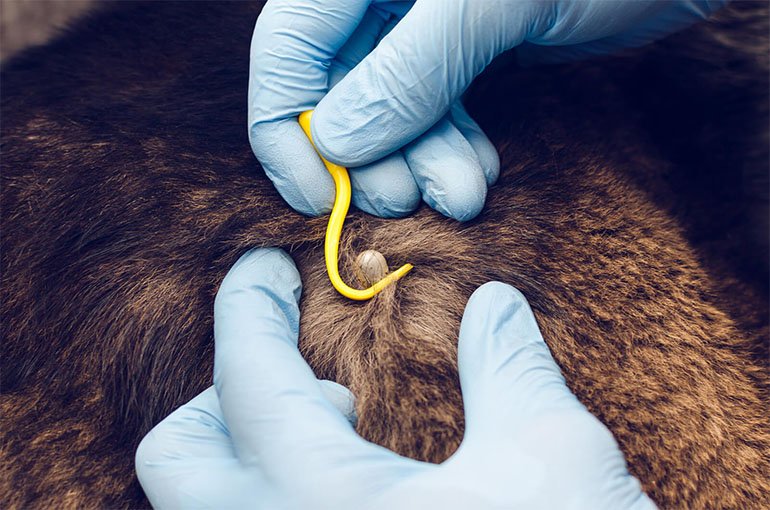Fleas are every pet parent’s nightmare. As soon as your dog starts scratching with greater-than-usual intensity, you are doomed to feel anxiety before yet another battle with these pesky bloodsucking critters. The agony is even greater if you don’t know what to expect – how long will they be around, and how long will they be able to persist in your home without food.
What are fleas exactly?
Fleas are small flightless insects that feed on mammalian and bird blood as external parasites. The most common species of flea in the US is the so-called cat flea, Ctenocephalides felis. Don’t let the name fool you – the cat flea will gladly go for dogs, many wild animals, and even humans.
As with many insects, fleas have several developmental stages – egg, larvae, pupae, and adult.
Why do fleas feed on blood?
Blood is a highly energetic food for fleas, containing high amounts of liquid, protein, hemoglobin, and iron – the substances a flea needs to survive and reproduce, all-in-one.
An additional quirk of fleas is that they practically feed their offspring by dropping excrement called “flea dirt,” which contains significant amounts of undigested host blood for larvae to feed on.
Females also use energy from the blood they do digest to produce additional, non-viable eggs, which are another staple food of flea larvae.
Flea larvae do not bite or suck hosts blood. They will find their first host as adults, when they emerge from their cocoons.
Where do the fleas come from?
Fleas are continuously in circulation due to urban wildlife, and feral or loose animals passing through neighborhoods. Flea eggs fall off from their fur and stay in the new territory. If they happen to find themselves in a yard which already has pets – the cycle begins, and a flea infestation is likely to occur if you don’t deal with the new flea reservoir.
Fortunately, today it is easy to treat dogs for fleas with a vast array of modern, safe and convenient products. You’ve probably already treated your pet with flea treatments or protective collars, either preventively or as a reaction a current flea issue.
The trouble is that the fleas have probably already set up an office in your living space, waiting to strike again as the protective substances weaken.
To manage the problem of fleas in your environment efficiently, you’ll need to know how long can they survive without food, and what developmental stages you’ll encounter during your struggle to get free from these tiny vampires.
How long can fleas survive without a host?
Since fleas have high-rate metabolism, they can’t last very long without a food source.
Four days is the longest time a feeding male adult flea can survive without a host. The time can be slightly extended in cool and highly humid environments that are rare, and in the case of immature adult fleas who haven’t fed yet.
Unfortunately, quick starvation counts for adults only. Flea larvae do not feed on blood at all – but on adult flea excrement and infertile flea eggs. As long as there are adult fleas and flea eggs somewhere in the environment, larvae will thrive and continue their development.
Other developmental stages – eggs and cocoons – can survive in your living space even longer. Adult fleas that have not yet emerged from the cocoon can enter a dormant state called quiescence. They can spend up to five months just sitting in their cocoons and waiting for a host (your pet) to come close.
Here is the full list of survival times for different developmental stages of fleas:
- Eggs – hatch in about 2 days; they can’t stay dormant.
- Larvae – will live for 7 days and then form a cocoon; if their food source is completely taken away, they die after about 3 days; this is hard to achieve in a home setup.
- Pupae – in normal circumstances, adults will come out of the cocoons in a week; however, they can stay dormant in the cocoons for up to five months.
- Male adults – 4 days without food for active adult feeders; about a week for young adults that haven’t fed yet.
- Female adults – around 24 hours; since making eggs is highly demanding from the energetic point of view, females waste away quicker than males.
In a home environment, the flea life cycle of is completed in 17 to 26 days, but due to quiescence, the infestation will probably last longer.
How to deal with fleas in your home
Human homes with pets offer stable and favorable conditions for fleas to thrive. Fleas and their babies are especially fond of hiding in our carpets, furniture spaces and forgotten corners of houses and yards.
All is not lost though since there are many efficient and easy ways to fight and kill fleas, even with simple home ingredients. It is worth it to put up a fight.
After you’ve successfully treated your pet using a flea shampoo – it can take up to 36 hours for all fleas on your dog to die after treatment – know that you’ve killed the main flea population.
However, you must also deal with the pupae, larvae, and eggs they left behind. A new generation of adults is sure to emerge in the process, but they shouldn’t be able to feed on your pet’s blood and continue to reproduce if he or she is treated.
From the moment you’ve treated your pets, there are three more steps to ensure you’ll get rid of the infestation as quickly as possible:
Home cleaning and vacuuming
This is a crucial step in your battle against fleas. The heat and pressure of a vacuum cleaner kill fleas in all life stages. Make sure to get the possible hotspots – furniture crevices, spaces under beds, carpets, and rugs. The vacuum will strengthen the carpet fiber, so it will be harder for larvae to hide. It also triggers adult fleas to emerge from pupae because of the heat and the pressure they feel from the machine. Vacuum every day, or at the very least every other day, for at least 8 weeks. The importance of vacuuming can’t be overstated.
One more thing fleas can’t survive is machine washing and drying, so make sure to wash all bed sheets and washable pillows and rugs, especially those used by your pet.
Treating your carpets
There are many carpet and furniture sprays offered for treating your home against fleas. The sprays range from classic insecticides to more advanced formulas like the Insect Growth Regulators (IGRs) -hormone-mimicking chemicals which stop further metamorphosis of fleas.
Treating your yard
Yards are natural reservoirs for fleas. Fleas enjoy shady, humid areas with dense vegetation. Besides using appropriate chemicals at hotspots, it might be good to clear areas that fit the description or prevent your pet from going there.
With all the steps taken, you just need to be diligent about cleaning and wait for the flea’s life cycles to run their course.
Natural and home remedies that can help with fleas
Besides pesticides and products such as IGRs, there are some simple substances from your household repertoire that can help you fight the flea infestation:
- Salt – When it the crystals get attached to fleas body they cause substantial damage to flea’s body. The action is based on the fact that salt crystals draw water. Spill and spread the fine-grained salt over your carpet and leave it for a week or slightly longer. Then vacuum thoroughly.
- Dish detergent traps – Dish detergent also dehydrates insects, by destroying the outer fatty layers on their bodies. Fill a very shallow plate with water and add a few drops of the soap. Leave it by a light source such as nightlight. The fleas will fall in and die. Commercial flea traps work similarly, but often include a light on their own.
- Botanical dust + Borate powder – The mix of the natural organic pesticide borate is used to kill larvae and eggs. Dust your carpets, beds, and other furniture and let it sit for a day, and then vacuum. You should be very careful not to breed in the mix. Use a mask while dusting and leave your home for 24 hours while the powder is doing is the job. Apply the mask again when vacuuming.
When will the fleas be gone from my home?
Most outbreaks will resolve themselves in about two months. In cases where the infestation has really taken root, it can take as long as 6 months for the fleas to disappear completely.
Don’t panic if you see new adults after all the treatments. New immature fleas will continue to emerge for months. They will try to feed on your pets’ blood, but won’t be successful if your pet has been treated with a proper dosage of flea drops. The spot treatment should be applied to all pets in your home.
As for yourself, the fleas may bite you, but human blood is not suitable for their reproduction. Wear pants and long-sleeved shirts to avoid bites and wash your sheets and clothes regularly.
If you’re feeling down about fleas, just remember that dealing with them is just a natural part of animal ownership, and be grateful we live in times when so many products are available to keep the miniature bloodsucking beasts under control.
Wrapping Up – So, how long can fleas actually live without a host?
So to answer the question that this article set out to solve, fleas can live four days without a host. This is on average and every infestation and flea outbreak may be different but usually fleas struggle to live any longer than that without a host.


3 comments